Menus
- Bikes from Ducati, Honda, Kawasaki, KTM and Triumph in comparison
- MOTORCYCLE scoring / test result
- Technical specifications
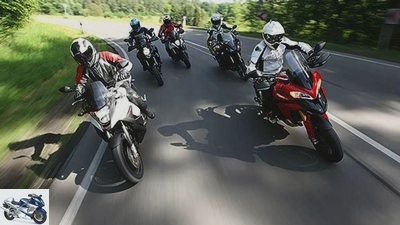
Jahn

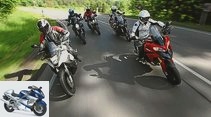
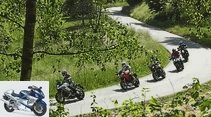
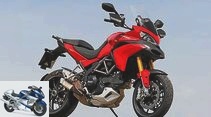
32 photos
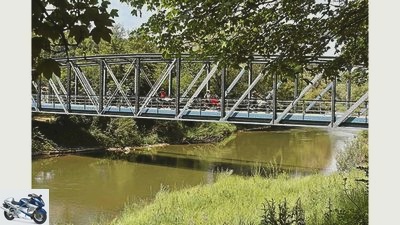
Jahn
1/32
Long distances are not a problem for the bikes – but they are just as suitable for the short after-work lap.
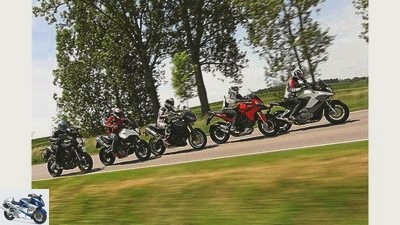
Jahn
2/32
Presentation of the bikes from the big funbike verifying test: Kawasaki Versys, KTM 990 SM T, Triumph Tiger 1050, Ducati Mulistrada 1200S and Honda Crossrunner.
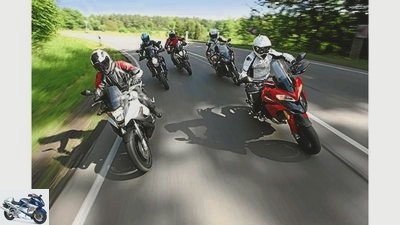
Jahn
3/32
Can the new Honda Crossrunner leave the competition behind?
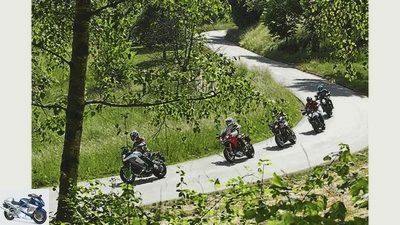
Jahn
4/32
With these fun bikes you can enjoy tight curves.
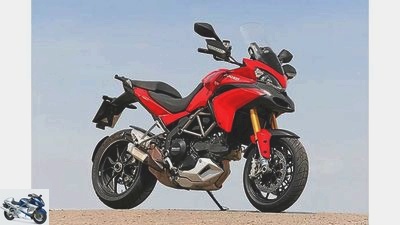
Jahn
5/32
The Ducati Multistrada 1200 S.
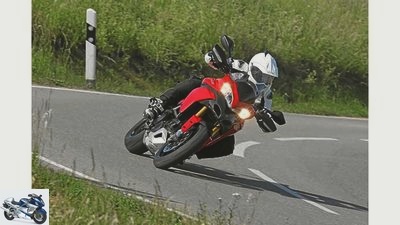
Jahn
6/32
The Multistrada is tall and very wide. Anyone who mills through the curve in a fully inclined position requires a correspondingly large amount of lane width and should be aware of this.
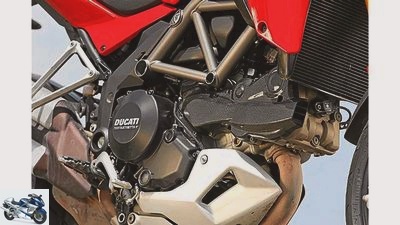
Jahn
7/32
Offers little running smoothness, but a lot of power: the 1200 V2 from the Ducati.
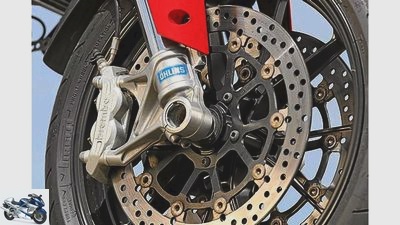
Jahn
8/32
The Brembo calipers grapple with the huge 320 millimeter discs, the ABS regulates the sporty and late on the Mulitstrada.
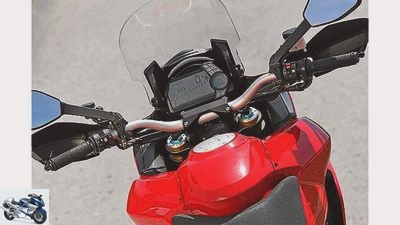
Jahn
9/32
Steering damper: The Ducati steering rod, which appears to be infinitely wide and moved close to the driver, offers a powerful lever, and the cockpit offers countless display functions. The narrow, strongly cranked Honda handlebars seem half-hearted, the rev counter is difficult to read.
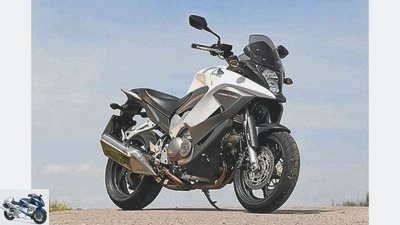
Jahn
10/32
The Honda Crossrunner.
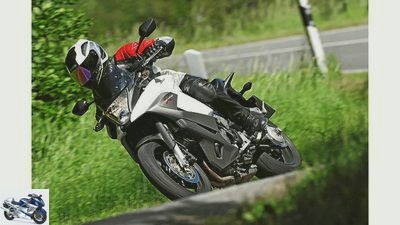
Jahn
11/32
The Crossrunner pleases with good cornering stability and high neutrality. The Honda struggles a bit in very tight alternating curves.
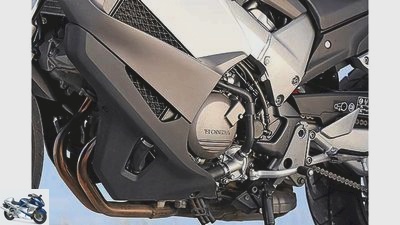
Jahn
12/32
Cultivated, but not very powerful: the Honda V4.
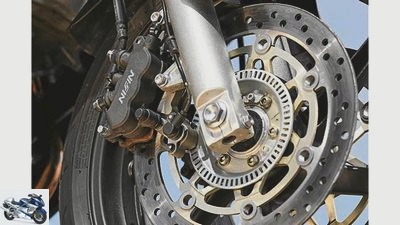
Jahn
13/32
The ABS combination brake is convincing in terms of effectiveness, controllability and foolproof ABS control behavior.
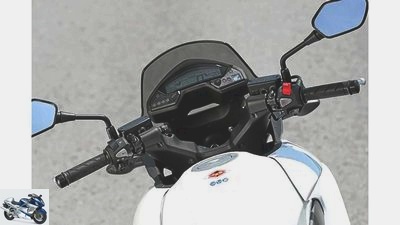
Jahn
14/32
The narrow, strongly cranked Honda handlebars seem half-hearted, the rev counter is difficult to read.
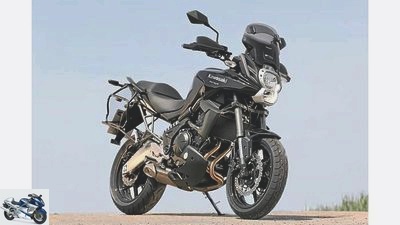
Jahn
15/32
The Kawasaki Versys.

Jahn
16/32
The lightweight Kawa is not lacking in handiness, but in well-mannered cornering behavior: feedback and stability are mediocre.
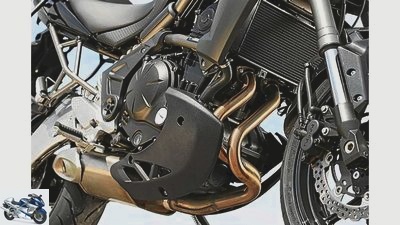
Jahn
17/32
The low-lying stub silencer lowers the center of gravity and promotes handling.
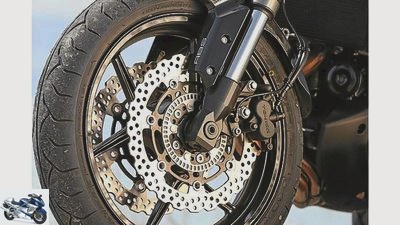
Jahn
18/32
The perforated wave disks and double-piston saddles only have a moderate effect.
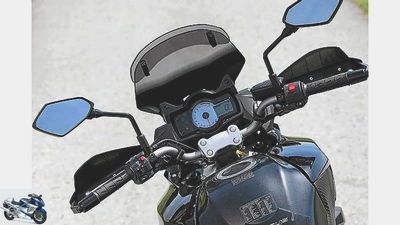
Jahn
19/32
Versys handlebars offer good compromises.
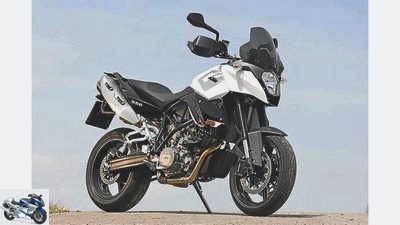
Jahn
20/32
The KTM 990 Supermoto T.
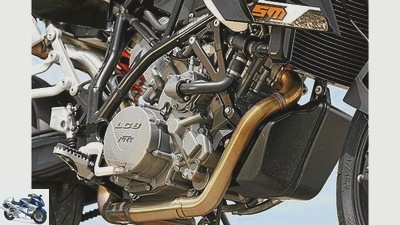
Jahn
21/32
The V2 engine hangs greedily on the gas and turns out to be a fun-loving jester.

Jahn
22/32
Snappy: the radially screwed Brembo calipers can be dosed perfectly.
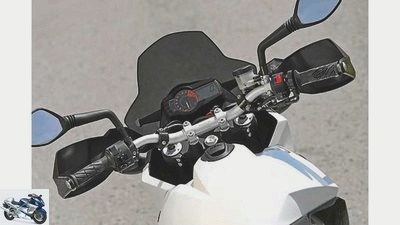
Jahn
23/32
The wide KTM bar fits almost perfectly.
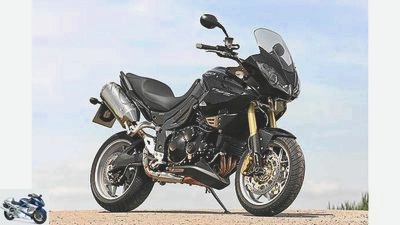
Jahn
24/32
The Triumph Tiger 1050.
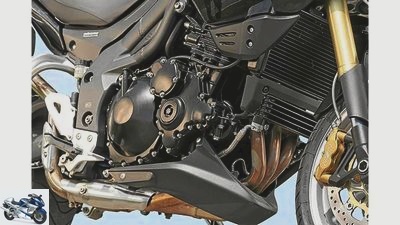
Jahn
25/32
The last bull: no other engine pushes so gently and at the same time so powerfully from 2000 rpm.
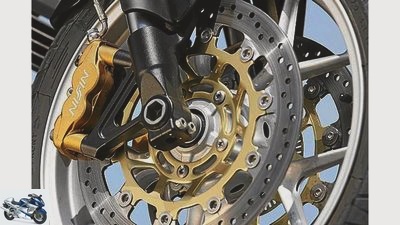
Jahn
26/32
The radially screwed Nissin saddles unfortunately only do average work.
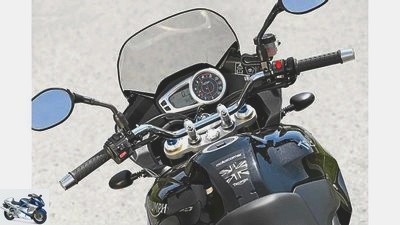
Jahn
27/32
The handlebars of the Tiger offer good compromises.
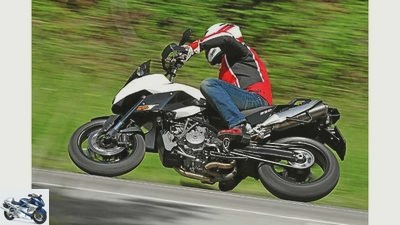
Jahn
28/32
The name says it all: The touring version of the 990 Supermoto seems to be born for cornering – the handy corner sweeper par excellence.
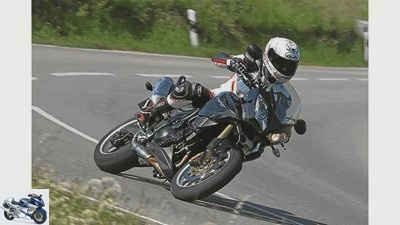
Jahn
29/32
The massive Tiger can be rushed quickly through curves on a good surface, but requires a lot of physical effort from the driver.

Jahn
30/32
Lawn and rest: Those who are out and about with the cool fun bikes rarely allow themselves short breaks. He doesn’t have to either: All five candidates offer enough comfort even for longer stages.
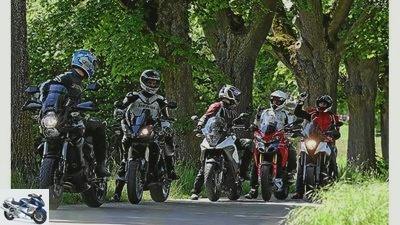
Jahn
31/32
Everyone has to move every bike from time to time, so they can ride a KTM or Ducati: the two V2 burners are in demand, discussions inevitable.
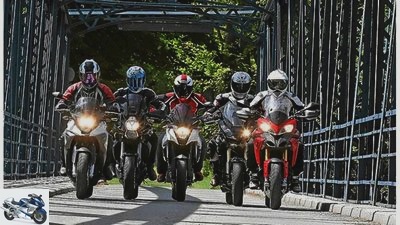
Jahn
32/32
Honda Crossrunner, Kawasaki Versys, KTM 990 SM T, Triumph Tiger 1050, Ducati Multistrada 1200S.
Comparison test funbikes 2011
Bikes from Ducati, Honda, Kawasaki, KTM and Triumph in comparison
The new concept mix called the Honda Crossrunner is facing the diverse fun bike competition. Can he assert himself in terms of driving fun and all-round qualities in comparison or he quickly goes away from laughing?
Fun has many faces, not everyone laughs at the same things. Hardly anything unites or separates people as sustainably as a common or different humor. Five bikes from four different countries with four different engine concepts meet here, from 64 to 148 hp, from the 650 twin to the 1200 Desmo V2, everything is there.
Be the first to enter D.ucati the show stage. With the clear argument of just under 150 hp with a weight of just over 230 kilograms. Too much steam? Matter of opinion. After all, the V2 borrowed from the 1198 super sports car was modified and its performance tamed. More flywheel mass, changed timing and intake channels should ensure more thump in the lower speed range and more smooth running. Part one of the exercise has certainly been successful: the V2 starts pulling off at 3000 rpm as if it were trying to save the world, stepping up a little at 5000 rpm and turning happily to just over 10,000 rpm. The thing with the running culture is not entirely successful, the jerky run of the V2 below the 3000 mark and the annoying constant-speed jolting still bothers. Playing around with the rocker buttons and selecting a different mode do not help here and also do little to change the hard, albeit direct throttle response.
Buy complete article
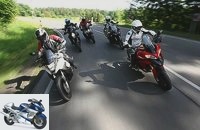
Comparison test funbikes 2011
Bikes from Ducati, Honda, Kawasaki, KTM and Triumph in comparison
Jahn
Everyone has to move every bike from time to time, so they can ride a KTM or Ducati: the two V2 burners are in demand, discussions inevitable.
Speaking of braking maneuvers: The bite and controllability of the Brembo stoppers are at a high level. The initially quite defensive ABS set-up has since given way to a revised, more aggressively sporty late-regulating ABS version. Pleasantly short braking distances are bought at the price of a rear wheel that lifts slightly in extreme cases. The Ducati also shows that driving fun and sportiness do not have to be at the expense of everyday practicality. The sweeping mirrors offer good consideration, night drivers are absolutely delighted with the very good light, and the (manually) adjustable window is the most effective protection against the wind. The new Honda should bring a breath of fresh air into the segment of travel-ready fun bikes. The Crossrunner is, to a large extent, an old acquaintance: The technology of the tried and tested VFR sports tourer is largely hidden under the new shell, with some conceptual changes, of course. Starting with the coordination of the suspension elements with longer suspension travel via the wider, raised handlebars to the newly designed cockpit and the tamer performance development.
Those who switch from the hard-pounding Ducati to the Honda will already experience significant differences in the sitting posture and engine characteristics. The Honda saddle spoils with a humane seat height, but the combination of relatively high, but not particularly wide handlebars and sporty footrests results in a somewhat strange sitting posture. There are few surprises when the engine is started: the V4 starts work spontaneously, runs smoothly and almost vibration-free at any speed. Small changes to the ingenious V-TEC valve control system as well as to the ignition and injection electronics reduce the maximum output of the engine by a few horses to 102 hp, ensure a fuller torque curve and smooth the transition from two- to four-valve operation. Although the V4 still doesn’t pull like a bull out of the cellar, the Crossrunner reconciles with its gentle response to the gas and its even and jerk-free power output.
A breath of fresh air comes into the framework at 6500 tours when the second intake and exhaust valve is switched on in each cylinder, which is noticeable as a subtle afterburner and makes the Honda happily turn up to almost 12,000 rpm. The fact that the torque values are so modest is due to the far too long final translation. In fifth and sixth gear, the top speed of the crossrunners is electronically limited to 200 km / h, only in fourth does the V4 turn freely up to the limiter speed of 11900 rpm. Under favorable conditions, fourth gear even holds well over 210 things. Should someone understand that, so much common sense in a fun bike? On the autobahn, the new one comes because of the only moderate wind protection "Adventure"-Fun bike anyway little joy. Adventure? Offroad? Just like the Ducati, the Honda rolls on travel enduro rubbers. The Pirelli Scorpion Trail, however, turn out to be rather good adhesive road tires with neutral cornering behavior. Neither the Pirellis nor the Crossrunner are suitable for real off-road trips. For brisk excursions on winding country roads, however, surprisingly good. The Honda can be thrown into an inclined position amazingly light-footed, willingly steers and remains very neutral in corners. However, it reaches its limits as soon as it comes to jagged lean changes in narrow terrain.
Jahn
Lawn and rest: Those who are out and about with the cool fun bikes rarely allow themselves short breaks. He doesn’t have to either: all five candidates offer enough comfort even for longer stages.
The non-adjustable fork is surprisingly brave. Its overall relatively soft basic set-up only leads to nervous pumping and trampling when the demands are high, and it never tends to bottom out even during the roughest braking maneuvers. And the brakes are impressive: the three-piston calipers of the Honda combination brake always bring the Crossrunner to a safe stop, finely adjustable and with a powerful bite, while the more defensive ABS works reliably. With a more sporty ABS control, even shorter braking distances could be achieved. But that’s the way he is, the crossrunner, a diplomatic mediator who, with a good view in the mirrors, excellent light and a very early warning of the fuel gauge, also focuses on safety and suitability for everyday use without neglecting driving pleasure. Kawasaki is taking a similar approach with the Versys. Anyone who primarily associates heating with driving fun will immediately point out the displacement and performance deficits of the lightweight 650s. Granted. But if you don’t necessarily need the brute power of a Ducati for happiness, you might like to make friends with the small, lively Kawa. At 211 kilograms, the Versys deserves the crown of the lightest bike in comparison, but that’s astonishingly high for a 650 twin-cylinder. In view of the only 64 HP output of the in-line two-cylinder, no torn trees are to be expected. However, the long-legged Japanese woman does very well in the draft measurement chapter and even reaches the Honda through to the rear.
But the 650 series can’t get much more praise in the engine / transmission section. Okay, you can pull up the gas already from 2000 tours and reap jolt-free propulsion, but the twin is very sleek in terms of running smoothness at any speed and annoying at medium speeds with pronounced vibrations. As expected, it doesn’t come out of the quark with a lot of pressure due to the lack of displacement, does it at least deliver great revving, right? Not at all. From the 7000 mark onwards, the Kawa engine looks listless, although the limiter gives it all freedom up to over 10,000 rpm. Hard shifting is always the order of the day anyway, but it’s not fun because the shift box is annoying with its ultra-long distances and bony, hard gear changes. Well, the lack of performance has to be compensated for by a hot-blooded driving style. Does the Versys deliver the agility you expect? Yes and no. Turning in and bending work effortlessly and without great effort, but the feedback and accuracy are not far off, and the less active sitting posture does not contribute to feeling good when cornering. Added to this is the Dunlop series tires, which convey little security and only offer moderate grip.
Even the extremely blunt acting, creaky-looking brakes are of no help at brisk curve hunting. After all, the Versys does not allow itself to be carried away to the handlebars even on the worst stretches, although the preload and rebound damping adjustable spring elements at the front and rear are quickly overwhelmed. The fork shines with a decent response, but the too soft strut messes up the overall balance and causes unrest. Apparently the Versys, which with its incredibly low fuel consumption enables enormous ranges, wants to be more of a touring bike than a fun bike.
Jahn
The massive Tiger can be rushed quickly through curves on a good surface, but requires a lot of physical effort from the driver.
The KTM 990 SM T sets different priorities, although the Austrians have trimmed this SM variant to be suitable for touring with a fairing window, larger tanks, lower seat height and reduced spring travel. But after a few meters of driving, the KTM makes it clear to whom the driving pleasure was written in the developer’s specifications. As soon as the driver assumes the specified sitting posture, the inner switch is set to sport. The notch position turned out to be sporty, but comfortable, the knee joint on the ultra-slim tank at the bottom is almost optimal, the high, barely cranked handlebars make the arrangement almost perfect. With a KTM-typical hard thump and pithy sound, the V2 gets down to business at the push of a button and hangs wonderfully directly on the gas. The clutch and transmission work just as smoothly as they are precise, and a subtle jerk warns the driver not to let the speed drop below 3000 rpm, even if the KTM engine does not act as jerkily in this area as the Ducati V2. From this threshold there is no stopping the Austrian until she is locked at around 9400 rpm. Powerful at the bottom, lively at the top, the 116 hp seem to have no trouble at all with the ridiculous 218 kg plus driver. But there is more to a brisk pace on winding country roads than pure performance. Here comes the Austrian’s big hour. Give in? Child’s play with razor-sharp precision. Handiness? Enormously.
The bustling light-footedness of the 990s goes hand in hand with a pleasant neutrality and stability, the KTM never seems overly nervous despite its liveliness and offers the finest feedback from the front wheel. The spring elements, which can be adjusted over a wide range, allow adaptation to almost all requirements. At full throttle on the highway, the grandiose agility takes revenge, here it seems a bit more nervous than the competition, without really getting into serious stirring. And while we’re at the complaint: Partly caused by the hard, very direct throttle response, the SM T shows slight but noticeable load change reactions.
But not only when it comes to propulsion, the 990 scores, especially when it comes to deceleration, it shines with top marks. Your snappy Brembo stoppers are a force and can be dosed most sensitively by far. The icing on the cake is that your ABS, which is now standard, controls the borderline with the lifting rear wheel so confidently and with short control intervals for phenomenally short braking distances. And if you don’t just bang your knife between your teeth over the house route, but also wants to move the KTM in everyday life, who is happy about the proper wind protection and seating comfort.
In the area of long-distance comfort, or rather, the Triumph Tiger once saw its true purpose. In the course of its development, the mighty Triumph has evolved more and more from a travel enduro to a comfortable fun bike for every day. But can the heavy (241 kilograms) Tiger really offer real fun bike character in the narrow terrain? Even the first seat test conveys a feeling of bulk and clumsiness, the Triumph tank spreads the driver’s knees significantly, the entire sitting posture is more comfortable and relaxed than active driving. The trainer steers the tiger by means of a handlebar, which is also wide but more strongly cranked, but lacks the necessary maneuverability for really wild cornering. The Briton has to be pushed into an inclined position with considerable effort, does not work as precisely when choosing the curve line and provides less feedback than KTM, Ducati or Honda. Only the Versys has less to offer here. The same applies to the coordination of the spring elements. Neither the fork nor the spring strut, which is too soft, especially in pillion rides, can provide the necessary reserves for confident boarding over bumpy passages.
Jahn
The lightweight Kawa is not lacking in handiness, but in well-mannered cornering behavior: feedback and stability are mediocre.
In fast, long curves on perfectly flat slopes, however, the Triumph shines with stable, neutral behavior and allows the engine to be exhausted. After all, the beefy three-cylinder is the highlight of the Tiger: Gently available power without end – the smoothly running treble starts pushing like crazy from 2000 rpm. Only those who open the gas in tight bends with a rough engine will notice disturbing load change reactions when the three-cylinder spontaneously shakes its power out of its sleeve. No wonder that the British predator cannot be beaten in the pull-through measurements.
In contrast, the controllability and control behavior of the ABS brakes are in need of improvement. If the effect is still okay, the lack of any feeling for the pressure point and the hardening of the lever when braking hard cannot be the last word. Because the hoarse sound of the powerful three-cylinder engine and the sublime driving experience in the comfortable saddle still turn on. And those who want to rob and travel alike can look forward to the good wind protection, the good view in the mirrors and the decent range of the relatively economical tigers. After all, the journey to the playground, i.e. the nearest curve Eldorado, or the alpine pass tour should be really fun.
MOTORCYCLE scoring / test result
Jahn
Can the new Honda Crossrunner leave the competition behind?
Scoring
engine
The three-of-a-kind wins: the smooth-running Triumph three-cylinder impresses with smooth power delivery and an incredibly powerful acceleration from the very bottom. When it comes to maximum performance, there is no herb against the almost 150 hp Ducati V2. The uncultivated run, especially below 3000 rpm, costs points, however. With the KTM-V2, the hard throttle response is the shortcoming, but the powerful acceleration and the revving give valuable meters. The smooth-running, gently responding V4 engine of the Honda, which is too long, suffers from the moderate thump from below. The small Kawa-Twin can practically not shine anywhere, but does quite well in view of its performance deficit in the measured values.
Winner engine: triumph
landing gear
The KTM offers the most curvy suspension. It steers in with agility, falls easily into an inclined position and delivers excellent feedback from the front wheel. The not-so-handy Ducati with the not-so-transparent steering behavior ends up just behind. Full points are awarded for the multi-electronically adjustable chassis. The amazingly handy, very neutral and extremely stable straight-ahead Honda pushes itself in front of the Triumph. Because the Tiger proves to be a somewhat clumsy fun tourer with a too soft, underdamped strut, it ends up just ahead of the handy Versys, which mainly suffers from its indifferent cornering behavior, moderate feedback and slack strut.
Chassis winner: KTM
everyday life
The opulent equipment helps the Ducati to victory in this chapter, although subjectively the Honda is the most uncomplicated everyday companion. The good wind protection and the comfortable seats for the driver and front passenger speak for the Multistrada, while driving around town the wide handlebars and the hard response behavior of the V2 bothers. The gentle Honda does not offer the most comfortable seats and poor wind protection, but excellent light and good manners all round. Kawasaki and Triumph are not very lavishly equipped, but the Versys puts their long range in the field, while the KTM, which almost tied for points, has their good workmanship and great seating position.
Everyday winners: Ducati
security
The excellent brakes of the KTM make the 990 the winner here. The stoppers from Honda and Ducati also do a good job, with the Italian’s ABS regulating too sportily and aggressively. The Tiger brake also ensures decent deceleration, but the ABS is not completely convincing. The muddy-looking, toothless Kawa brake consistently delivers a rather unsatisfactory performance.
Safety winner: KTM
costs
Good or just cheap? The Versys wins with its very low fuel consumption and low maintenance costs. Bargain hunters are spot on with the 650 Kawa.
Winner cost: Kawasaki
| 1000 | Ducati | Honda | KTM | Kawasakai | triumph | Overall rating | 686 | 652 | 668 | 600 | 648 | placement | 1. | 3. | 2. | 5. | 4th. | Price-performance note | 1.0 | 3.2 | 1.8 | 2.0 | 1.9 | 2.2 |
Winner price-performance
With a respectable number of points, the Honda deserves the best price-performance rating in comparison thanks to its relatively low price.
Price-performance winner: Honda
Jahn
The Ducati Multistrada 1200 S.
Test result
1. Ducati Multistrada 1200 S
The powerful V2, its extensive equipment and the very variable, electronically adjustable chassis secure the victory for the Ducati.
2. KTM 990 SM T
A first-class, super-handy chassis, a strong, easy-turning V2 and the crispest brakes in comparison put the KTM in second place. Subjectively, the true, real fun bike.
3. Honda Crossrunner
The Honda scores secretly, but steadily: with the amazingly handy, neutral driving behavior, the cultivated engine and the good brakes. An all-rounder without extremes.
4th Triumph Tiger 1050
The gentle, extremely brawny three-cylinder is the highlight of the Triumph. It cannot offer absolute handiness, but comfort, wind protection and everyday manners.
5. Kawasaki Versys
The Kawasaki scores with its low price, low consumption and handiness. Their chassis qualities are modest, and the slack brakes deserve real criticism.
Technical specifications
Jahn
The V2 engine of the KTM hangs greedily on the gas and proves to be a fun-loving man.
Ducati Multistrada 1200S
| engine | design type | Two cylinder four stroke 90 degree V engine |
| injection | Ø 64 mm | coupling | Multi-disc oil bath clutch (anti-hopping) |
| Bore x stroke | 106.0 x 67.9 mm | Displacement | 1198 cm3 |
| compression | 11.5: 1 | power | 108.8 kW (148 hp) at 9250 rpm |
| Torque | 119 Nm at 7500 rpm | landing gear |
| frame | Steel tubular frame, engine is load-bearing | fork | Upside-down fork, Ø 48 mm |
| Brakes v / h | Ø 320 mm / Ø 245 mm | Assistance systems | ABS / traction control |
| bikes | 3.50 x 17; 6.00 x 17 | tires | 120/70 ZR 17; 190/55 ZR 17 |
| Tires | Pirelli Scorpion Trail | mass and weight |
| wheelbase | 1530 mm | Steering head angle | 65.0 degrees |
| trailing | 104 mm | Suspension travel v / h | 170/170 mm |
| Seat height ** | 840 mm | Weight with full tank ** | 234 kg |
| Payload ** | 196 kg | Tank capacity / reserve | 20.0 / 4.0 liters |
| Service intervals | 12,000 km | price | 18 250 euros |
| Price test motorcycle | – | Additional costs | 255 euros | MOTORCYCLE readings | Top speed * | 245 km / h |
| acceleration | 0-100 km / h | 3.3 sec |
| 0-140 km / h | 5.2 sec | 0-200 km / h | 10.1 sec |
| Draft | 60-100 km / h | 4.1 sec |
| 100-140 km / h | 4.3 sec | 140-180 km / h | 4.9 sec |
| consumption | Consumption highway | 5.7 liters / super |
| Reach country road | 351 km |
Honda Crossrunner
| engine | design type | Four cylinder four stroke 90 degree V engine |
| injection | Ø 36 mm | coupling | Multi-disc oil bath clutch |
| Bore x stroke | 72.0 x 48.0 mm | Displacement | 782 cm3 |
| compression | 11.6: 1 | power | 75.0 kW (102 hp) at 10,000 rpm |
| Torque | 74 Nm at 9250 rpm | landing gear |
| frame | Bridge frame made of aluminum | fork | Telescopic fork, Ø 43 mm |
| Brakes v / h | Ø 296 mm / Ø 256 mm | Assistance systems | Partly integral braking system with ABS |
| bikes | 3.50 x 17; 5.50 x 17 | tires | 120/70 ZR 17; 180/55 ZR 17 |
| Tires | Pirelli Scorpion Trail | mass and weight |
| wheelbase | 1464 mm | Steering head angle | 64.6 degrees |
| trailing | 96 mm | Suspension travel v / h | 165/145 mm |
| Seat height ** | 810 mm | Weight with full tank ** | 239 kg |
| Payload ** | 194 kg | Tank capacity / reserve | 21.5 / – liters |
| Service intervals | 12,000 km | price | 10 790 euros |
| Price test motorcycle | – | Additional costs | 170 euros | MOTORCYCLE readings | Top speed * | 200 km / h |
| acceleration | 0-100 km / h | 3.7 sec |
| 0-140 km / h | 6.2 sec | 0-200 km / h | 16.4 sec |
| Draft | 60-100 km / h | 5.6 sec |
| 100-140 km / h | 6.5 sec | 140-180 km / h | 9.2 sec |
| consumption | Consumption highway | 5.1 liters / normal |
| Reach country road | 422 km |
KTM 990 SM T
| engine | design type | Two-cylinder four-stroke 75 degree V engine |
| injection | Ø 48 mm | coupling | Multi-disc oil bath clutch |
| Bore x stroke | 101.0 x 62.4 mm | Displacement | 1000 cm3 |
| compression | 11.5: 1 | power | 85.0 kW (116 hp) at 9000 rpm |
| Torque | 97 Nm at 7000 rpm | landing gear |
| frame | Steel tubular frame, engine is load-bearing | fork | Upside-down fork, Ø 48 mm |
| Brakes v / h | Ø 305 mm / Ø 240 mm | Assistance systems | SECTION |
| bikes | 3.50 x 17; 5.50 x 17 | tires | 120/70 ZR 17; 180/55 ZR 17 |
| Tires | Continental Sport Attack | mass and weight |
| wheelbase | 1505 mm | Steering head angle | 65.6 degrees |
| trailing | 109 mm | Suspension travel v / h | 160/180 mm |
| Seat height ** | 850 mm | Weight with full tank ** | 218 kg |
| Payload ** | 182 kg | Tank capacity / reserve | 19.0 / 3.7 liters |
| Service intervals | 7500 km | price | 12 595 euros |
| Price test motorcycle | – | Additional costs | 200 euros | MOTORCYCLE readings | Top speed * | 220 km / h |
| acceleration | 0-100 km / h | 3.6 sec |
| 0-140 km / h | 5.8 sec | 0-200 km / h | 12.0 sec |
| Draft |
60-100 km / h | 4.8 sec |
| 100-140 km / h | 4.6 sec | 140-180 km / h | 5.7 sec |
| consumption | Consumption highway | 5.5 liters / super |
| Reach country road | 345 km |
Kawasaki Versys
| engine | design type | Two-cylinder four-stroke in-line engine |
| injection | Ø 38 mm | coupling | Multi-disc oil bath clutch |
| Bore x stroke | 83.0 x 60.0 mm | Displacement | 649 cm3 |
| compression | 10.6: 1 | power | 47.0 kW (64 PS) at 8000 rpm |
| Torque | 61 Nm at 6800 rpm | landing gear |
| frame | Steel tubular frame, engine is load-bearing | fork | Upside-down fork, Ø 41 mm |
| Brakes v / h | Ø 300 mm / Ø 220 mm | Assistance systems | SECTION |
| bikes | 3.50 x 17; 4.50 x 17 | tires | 120/70 ZR 17; 160/60 ZR 17 |
| Tires | Dunlop D 221 “G” | mass and weight |
| wheelbase | 1415 mm | Steering head angle | 65.0 degrees |
| trailing | 108 mm | Suspension travel v / h | 150/145 mm |
| Seat height ** | 835 mm | Weight with full tank ** | 211 kg |
| Payload ** | 178 kg | Tank capacity / reserve | 19.0 / 3.0 liters |
| Service intervals | 6000 km | price | 8195 euros |
| Price test motorcycle | 8348 euros *** | Additional costs | 180 euros | MOTORCYCLE readings | Top speed * | 185 km / h |
| acceleration | 0-100 km / h | 4.1 sec |
| 0-140 km / h | 8.3 sec | 0-200 km / h | – |
| Draft | 60-100 km / h | 4.8 sec |
| 100-140 km / h | 5.5 sec | 140-180 km / h | 10.5 sec |
| consumption |
Consumption highway | 4.0 liters / normal |
| Reach country road | 475 km |
Triumph Tiger 1050
| engine | design type | Three-cylinder four-stroke in-line engine |
| injection | Ø 46 mm | coupling | Multi-disc oil bath clutch |
| Bore x stroke | 79.0 x 71.4 mm | Displacement | 1050 cm3 |
| compression | 12:01 pm | power | 84.6 kW (115 PS) at 9400 rpm |
| Torque | 100 Nm at 6250 rpm | landing gear |
| frame | Bridge frame made of aluminum | fork | Upside-down fork, Ø 43 mm |
| Brakes v / h | Ø 320 mm / Ø 255 mm | Assistance systems | SECTION |
| bikes | 3.50 x 17; 5.50 x 17 | tires | 120/70 ZR 17; 180/55 ZR 17 |
| Tires | Michelin Pilot Road “S” | mass and weight |
| wheelbase | 1510 mm | Steering head angle | 66.8 degrees |
| trailing | 88 mm | Suspension travel v / h | 150/150 mm |
| Seat height ** | 850 mm | Weight with full tank ** | 241 kg |
| Payload ** | 187 kg | Tank capacity / reserve | 20.0 / 4.5 liters |
| Service intervals | 10,000 km | price | 11 590 euros |
| Price test motorcycle | 12 190 euros³ | Additional costs | 350 Euro | MOTORCYCLE readings | Top speed * | 220 km / h |
| acceleration |
0-100 km / h | 3.4 sec |
| 0-140 km / h | 5.5 sec | 0-200 km / h | 12.1 sec |
| Draft | 60-100 km / h | 3.5 sec |
| 100-140 km / h | 3.9 sec | 140-180 km / h | 5.6 sec |
| consumption | Consumption highway | 5.1 liters / super |
| Reach country road | 392 km |
* Manufacturer information, ** MOTORCYCLE measurements, *** incl. ABS (600 euros), ³incl. Vario windshield (128 euros) and hand protectors (25 euros)
archive
The performance chart.
The Ducati outperforms everyone. From 5000 rpm, the sporty and aggressive Multistrada-V2 clearly distances itself from the competition, but the maximum output of almost 150 hp is rarely used in everyday life. The KTM-V2 also goes to work very suddenly and directly, spontaneously pushing itself out of the lower rev range, but only soaks up to top form with increasing revs. The Triumph three-cylinder offers the fullest thump and pushes incredibly powerful from 2000 rpm. From around 3000 rpm there are always over 90 Newton meters available, the plateau-shaped torque curve says everything about the character of the Tiger engine. The evenly rising curve of the VFR with the slight upward bend at 6500 rpm (switching from two to four valve operation) reveals the very harmonious power delivery of the V4. Amazing: In two-valve operation, the VFR is barely above the lower-displacement and less powerful Kawasaki. Above all, the Versys disappoints with its tame performance development and the lack of revving above 7000 rpm.
Related articles
-
Ducati Multistrada 1200, Kawasaki Versys 1000 and Triumph Tiger 1050 in the test
Gargolov Funbikes in comparison test Ducati Multistrada 1200, Kawasaki Versys 1000 and Triumph Tiger 1050 With bag and pack on a big tour or simply …
-
Triumph, Harley Davidson, Kawasaki and Honda Cruiser in the test
Jahn Chopper from Triumph, Harley Davidson, Kawasaki and Honda in the test Comparative test of mid-range cruisers up to 9,000 euros In the field of cruisers, the …
-
Comparison test touring enduro bikes: Honda Transalp, Kawasaki Versys, Suzuki V-Strom 650
Jahn comparison test travel enduro: Honda Transalp, Kawasaki Versys, Suzuki V-Strom 650 Always on the wall, travel enduro does not necessarily mean BMW …
-
Comparison test Honda Hornet 600 ABS, Kawasaki Z 750 ABS and Triumph Street Triple
Artist comparison test Honda Hornet 600 ABS, Kawasaki Z 750 ABS and Triumph Street Triple Weekend Warriors Life is almost sterile. Engines…
-
Kawasaki Versys 1000, Triumph Tiger 1050 Sport, Honda Crossrunner in comparison test
28 pictures 1/28 After the romping comes the touring: petrol talks at the former coal port in Karlsruhe ….
-
Honda, Kawasaki, Suzuki, Yamaha, Triumph
Jahn Honda, Kawasaki, Suzuki, Yamaha, Triumph Test 600 super sports car But that’s enough, the Kawa boys decided. It’s time for something new. To the…
-
39 pictures 1/39 The Triumph Speed Triple: The price 11,740 euros (the test motorcycle with windshield for 245 euros and …
-
New products: BMW, Ducati, Honda and Kawasaki
Innovations: BMW, Ducati, Honda and Kawasaki Ducati remains extreme Motorcycles with a sharp character profile are a specialty of the Bolognese and had …
-
Ducati Multistrada 1200 S Touring, Kawasaki Versys 1000, Triumph Tiger 1050 Sport
fact 22 pictures fact 1/22 Ducati Multistrada 1200 S Touring, Kawasaki Versys 1000 and Triumph Tiger 1050 Sport. The funbikes with 17-inch tires in …
-
BMW F 800 GT, Kawasaki Z 1000 SX and Honda VFR 800 F in the test
fact 44 pictures fact 1/44 fact 2/44 fact 3/44 fact 4/44 fact 5/44 Praise to the diversity: The three test candidates all want the same thing, but are looking for it …